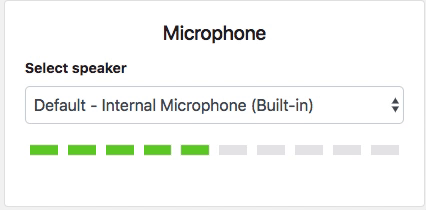еңЁJavascriptдёӯжЈҖжҹҘйәҰе…ӢйЈҺйҹійҮҸ
жҲ‘жӯЈеңЁе°қиҜ•еҲ¶дҪңдёҖж¬ҫйңҖиҰҒи®ҝй—®з”ЁжҲ·йәҰе…ӢйЈҺзҡ„е°ҸжёёжҲҸгҖӮжҲ‘йңҖиҰҒиғҪеӨҹжЈҖжҹҘйәҰе…ӢйЈҺжҳҜеҗҰе·ІиҝһжҺҘпјҢ然еҗҺеҰӮжһңжҳҜпјҢиҜ·жЈҖжҹҘеңЁжёёжҲҸжҢҒз»ӯж—¶й—ҙеҶ…йҖҡиҝҮйәҰе…ӢйЈҺдј жқҘзҡ„еЈ°йҹійҹійҮҸгҖӮжҲ‘иҜҘжҖҺд№ҲеҒҡпјҹ
5 дёӘзӯ”жЎҲ:
зӯ”жЎҲ 0 :(еҫ—еҲҶпјҡ12)
еңЁиҮӘе·ұи§ЈеҶід№ӢеҗҺпјҢзЁҚеҫ®иҜҰз»ҶдёҖзӮ№зҡ„зӯ”жЎҲеҸҜиғҪдјҡеё®еҠ©е…¶д»–дәәеңЁиҝҷйҮҢеҜ»жүҫгҖӮ
д»ҘдёӢд»Јз Ғе°Ҷж №жҚ®йәҰе…ӢйЈҺзҡ„йҹійҮҸжіЁй”ҖеӨ§зәҰ0еҲ°100зҡ„ж•°еӯ—гҖӮ
navigator.mediaDevices.getUserMedia({ audio: true, video: true })
.then(function(stream) {
audioContext = new AudioContext();
analyser = audioContext.createAnalyser();
microphone = audioContext.createMediaStreamSource(stream);
javascriptNode = audioContext.createScriptProcessor(2048, 1, 1);
analyser.smoothingTimeConstant = 0.8;
analyser.fftSize = 1024;
microphone.connect(analyser);
analyser.connect(javascriptNode);
javascriptNode.connect(audioContext.destination);
javascriptNode.onaudioprocess = function() {
var array = new Uint8Array(analyser.frequencyBinCount);
analyser.getByteFrequencyData(array);
var values = 0;
var length = array.length;
for (var i = 0; i < length; i++) {
values += (array[i]);
}
var average = values / length;
console.log(Math.round(average));
// colorPids(average);
}
})
.catch(function(err) {
/* handle the error */
});
еҰӮжһңжӮЁжңүжӯӨж•°еӯ—пјҢеҲҷjqueryеҸҜд»ҘеҜ№йўңиүІеқ—иҝӣиЎҢж ·ејҸи®ҫзҪ®гҖӮжҲ‘еңЁдёӢйқўжҸҗдҫӣдәҶдёҖдёӘзӨәдҫӢеҠҹиғҪпјҢдҪҶиҝҷжҳҜз®ҖеҚ•зҡ„йғЁеҲҶгҖӮеҸӘйңҖеҸ–ж¶ҲжіЁйҮҠ йўңиүІpidsеҠҹиғҪгҖӮ
function colorPids(vol) {
let all_pids = $('.pid');
let amout_of_pids = Math.round(vol/10);
let elem_range = all_pids.slice(0, amout_of_pids)
for (var i = 0; i < all_pids.length; i++) {
all_pids[i].style.backgroundColor="#e6e7e8";
}
for (var i = 0; i < elem_range.length; i++) {
// console.log(elem_range[i]);
elem_range[i].style.backgroundColor="#69ce2b";
}
}
дёәзЎ®дҝқе°ҪеҸҜиғҪиҜҰз»Ҷең°еӣһзӯ”жӯӨй—®йўҳпјҢжҲ‘иҝҳеңЁдёӢйқўйҷ„еҠ дәҶжҲ‘зҡ„htmlе’ҢcssпјҢеӣ жӯӨпјҢеҰӮжһңжӮЁеёҢжңӣеҗҜеҠЁе№¶иҝҗиЎҢдёҖдёӘжңүж•Ҳзҡ„зӨәдҫӢпјҢеҲҷеҸӘйңҖеӨҚеҲ¶js htmlе’ҢcssгҖӮ
htmlпјҡ
<div class="pids-wrapper">
<div class="pid"></div>
<div class="pid"></div>
<div class="pid"></div>
<div class="pid"></div>
<div class="pid"></div>
<div class="pid"></div>
<div class="pid"></div>
<div class="pid"></div>
<div class="pid"></div>
<div class="pid"></div>
</div>
cssпјҡ
.pids-wrapper{
width: 100%;
}
.pid{
width: calc(10% - 10px);
height: 10px;
display: inline-block;
margin: 5px;
}
зӯ”жЎҲ 1 :(еҫ—еҲҶпјҡ3)
д»ҘдёӢжҳҜжЈҖжөӢйҹійў‘жҺ§д»¶жүҖйңҖзҡ„д»Јз Ғж®өпјҲжқҘиҮӘпјҡhttps://developer.mozilla.org/en-US/docs/Web/API/Navigator/getUserMediaпјү
navigator.getUserMedia(constraints, successCallback, errorCallback);
д»ҘдёӢжҳҜдҪҝз”ЁgetUserMediaеҮҪж•°зҡ„зӨәдҫӢпјҢиҜҘеҮҪж•°еҸҜи®©жӮЁи®ҝй—®йәҰе…ӢйЈҺгҖӮ
navigator.getUserMedia = navigator.getUserMedia ||
navigator.webkitGetUserMedia ||
navigator.mozGetUserMedia;
if (navigator.getUserMedia) {
navigator.getUserMedia({ audio: true, video: { width: 1280, height: 720 } },
function(stream) {
console.log("Accessed the Microphone");
},
function(err) {
console.log("The following error occured: " + err.name);
}
);
} else {
console.log("getUserMedia not supported");
}
иҝҷжҳҜдёҖдёӘеұ•зӨәжӮЁжғіиҰҒзҡ„вҖңиҫ“е…ҘйҮҸвҖқзҡ„еӯҳеӮЁеә“гҖӮ
зӯ”жЎҲ 2 :(еҫ—еҲҶпјҡ3)
з®ҖеҚ•йәҰе…ӢйЈҺVu MeterиҜ·еҸӮйҳ…https://codepen.io/www-0av-com/pen/jxzxEX
еңЁ2018е№ҙжЈҖжҹҘ并иҝҗиЎҢпјҢеҢ…жӢ¬ChromeжөҸи§ҲеҷЁдёӯе®үе…Ёжӣҙж–°еҜјиҮҙзҡ„й”ҷиҜҜдҝ®еӨҚгҖӮ
HTML
В В В В #include <iostream>
#include <vector>
#include <algorithm>
int main() {
std::vector<int> v1{ 458, 525, 255, 336, 258 };
std::vector<int> v2;
while ( v1.size() ) {
auto m = std::min_element(v1.begin(), v1.end());
v2.push_back(*m);
v1.erase(m);
}
for (auto v : v1) std::cout << v << " "; std::cout << "\n";
for (auto v : v2) std::cout << v << " "; std::cout << "\n";
return 0;
}
CSS
<h3>VU meter from mic input (getUserMedia API)</h3>
<button onclick="startr();" title="click start needed as security in browser increased and voice mic can only be started from a gesture on page">Start</button>
<canvas id="canvas" width="150" height="300" style='background:blue'></canvas>
<br>
CLICK START
<div align=left>See JS for attribution</div>JSпјҲйңҖиҰҒJQueryпјү
body {
color: #888;
background: #262626;
margin: 0;
padding: 40px;
text-align: center;
font-family: "helvetica Neue", Helvetica, Arial, sans-serif;
}
#canvas {
width: 150px;
height: 100px;
position: absolute;
top: 150px;
left: 45%;
text-align: center;
}
зӯ”жЎҲ 3 :(еҫ—еҲҶпјҡ3)
д»ҘдёӢжҳҜдҪҝз”ЁsetTimeoutиҖҢдёҚжҳҜдёҚжҺЁиҚҗдҪҝз”Ёзҡ„createScriptProcessorеҮҪж•°зҡ„зӯ”жЎҲпјҡ
(async () => {
let volumeCallback = null;
let volumeInterval = null;
const volumeVisualizer = document.getElementById('volume-visualizer');
const startButton = document.getElementById('start');
const stopButton = document.getElementById('stop');
// Initialize
try {
const audioStream = await navigator.mediaDevices.getUserMedia({
audio: {
echoCancellation: true
}
});
const audioContext = new AudioContext();
const audioSource = audioContext.createMediaStreamSource(audioStream);
const analyser = audioContext.createAnalyser();
analyser.fftSize = 512;
analyser.minDecibels = -127;
analyser.maxDecibels = 0;
analyser.smoothingTimeConstant = 0.4;
audioSource.connect(analyser);
const volumes = new Uint8Array(analyser.frequencyBinCount);
volumeCallback = () => {
analyser.getByteFrequencyData(volumes);
let volumeSum = 0;
for(const volume of volumes)
volumeSum += volume;
const averageVolume = volumeSum / volumes.length;
// Value range: 127 = analyser.maxDecibels - analyser.minDecibels;
volumeVisualizer.style.setProperty('--volume', (averageVolume * 100 / 127) + '%');
};
} catch(e) {
console.error('Failed to initialize volume visualizer, simulating instead...', e);
// Simulation
//TODO remove in production!
let lastVolume = 50;
volumeCallback = () => {
const volume = Math.min(Math.max(Math.random() * 100, 0.8 * lastVolume), 1.2 * lastVolume);
lastVolume = volume;
volumeVisualizer.style.setProperty('--volume', volume + '%');
};
}
// Use
startButton.addEventListener('click', () => {
// Updating every 100ms (should be same as CSS transition speed)
if(volumeCallback !== null && volumeInterval === null)
volumeInterval = setInterval(volumeCallback, 100);
});
stopButton.addEventListener('click', () => {
if(volumeInterval !== null) {
clearInterval(volumeInterval);
volumeInterval = null;
}
});
})();div {
--volume: 0%;
position: relative;
width: 200px;
height: 20px;
margin: 50px;
background-color: #DDD;
}
div::before {
content: '';
position: absolute;
top: 0;
bottom: 0;
left: 0;
width: var(--volume);
background-color: green;
transition: width 100ms linear;
}
button {
margin-left: 50px;
}
h3 {
margin: 20px;
font-family: sans-serif;
}<h3><b>NOTE:</b> This is not accurate on stackoverflow, since microphone use is not permitted. It's a simulation instead.</h3>
<div id="volume-visualizer"></div>
<button id="start">Start</button>
<button id="stop">Stop</button>
иҝҷд№ҹж„Ҹе‘ізқҖпјҢе®ғеҸҜд»ҘжҢүйңҖиҪ»жқҫеҗҜеҠЁе’ҢеҒңжӯўгҖӮ
зӯ”жЎҲ 4 :(еҫ—еҲҶпјҡ0)
жҲ‘иҝҳжІЎжңүжЈҖжҹҘиҝҮиҝҷдёӘеә“зҡ„д»Јз ҒпјҢдҪҶonline demoдјјд№Һжңүж•Ҳпјҡ
- з”ЁCпјғи®ҫзҪ®йәҰе…ӢйЈҺйҹійҮҸ
- JMFйәҰе…ӢйЈҺйҹійҮҸжҺ§еҲ¶еҷЁ
- иҺ·еҸ–йәҰе…ӢйЈҺйҹійҮҸ
- жқҘиҮӘjavascriptзҡ„йәҰе…ӢйЈҺйҹійҮҸжҺ§еҲ¶
- Silverlight MacйәҰе…ӢйЈҺйҹійҮҸ
- жЈҖжҹҘiPhoneдёӯзҡ„йәҰе…ӢйЈҺйҹійҮҸ
- и°ғж•ҙйәҰе…ӢйЈҺеҪ•йҹійҹійҮҸ
- и°ғж•ҙйәҰе…ӢйЈҺиҫ“е…ҘйҹійҮҸ
- Flex4 - йәҰе…ӢйЈҺеўһзӣҠдёҺOSйәҰе…ӢйЈҺиҫ“е…ҘйҹійҮҸ
- еңЁJavascriptдёӯжЈҖжҹҘйәҰе…ӢйЈҺйҹійҮҸ
- жҲ‘еҶҷдәҶиҝҷж®өд»Јз ҒпјҢдҪҶжҲ‘ж— жі•зҗҶи§ЈжҲ‘зҡ„й”ҷиҜҜ
- жҲ‘ж— жі•д»ҺдёҖдёӘд»Јз Ғе®һдҫӢзҡ„еҲ—иЎЁдёӯеҲ йҷӨ None еҖјпјҢдҪҶжҲ‘еҸҜд»ҘеңЁеҸҰдёҖдёӘе®һдҫӢдёӯгҖӮдёәд»Җд№Ҳе®ғйҖӮз”ЁдәҺдёҖдёӘз»ҶеҲҶеёӮеңәиҖҢдёҚйҖӮз”ЁдәҺеҸҰдёҖдёӘз»ҶеҲҶеёӮеңәпјҹ
- жҳҜеҗҰжңүеҸҜиғҪдҪҝ loadstring дёҚеҸҜиғҪзӯүдәҺжү“еҚ°пјҹеҚўйҳҝ
- javaдёӯзҡ„random.expovariate()
- Appscript йҖҡиҝҮдјҡи®®еңЁ Google ж—ҘеҺҶдёӯеҸ‘йҖҒз”өеӯҗйӮ®д»¶е’ҢеҲӣе»әжҙ»еҠЁ
- дёәд»Җд№ҲжҲ‘зҡ„ Onclick з®ӯеӨҙеҠҹиғҪеңЁ React дёӯдёҚиө·дҪңз”Ёпјҹ
- еңЁжӯӨд»Јз ҒдёӯжҳҜеҗҰжңүдҪҝз”ЁвҖңthisвҖқзҡ„жӣҝд»Јж–№жі•пјҹ
- еңЁ SQL Server е’Ң PostgreSQL дёҠжҹҘиҜўпјҢжҲ‘еҰӮдҪ•д»Һ第дёҖдёӘиЎЁиҺ·еҫ—第дәҢдёӘиЎЁзҡ„еҸҜи§ҶеҢ–
- жҜҸеҚғдёӘж•°еӯ—еҫ—еҲ°
- жӣҙж–°дәҶеҹҺеёӮиҫ№з•Ң KML ж–Ү件зҡ„жқҘжәҗпјҹ
